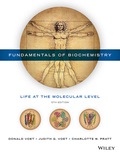
Concept explainers
Concept introduction: Enzymes are the biocatalyst that accelerate the
Answer to Problem 1E
Correct answer: The best description for enzyme is: It increases the rate at which a chemical reaction approaches the equilibrium relative to its uncatalyzed rate. Hence, option b. is the correct answer.
Explanation of Solution
Reason for the correct statement:
Option b. is given as, “It increases the rate at which a chemical reaction approaches equilibrium relative to its catalyzed rate”. If the activation energy is low, the rate will be faster. Enzymes speed up the reactions by lowering the activation energy. However, the reaction reaches the equilibrium much faster when the enzyme is present as the rate of the reaction is increased. Hence, option b. is the correct answer.
Reasons for the incorrect statements:
Option a. is given as, “It allows a chemical reaction to proceed extremely fast”. The factors that deal with the rate of chemical reaction that proceeds the reaction faster is called the
Option c. is given as, “It makes a reaction
Conclusion: Enzymes increase the rate at which a chemical reaction approaches equilibrium relative to its catalyzed rate.
Want to see more full solutions like this?
Chapter 11 Solutions
Fundamentals of Biochemistry: Life at the Molecular Level
 BiochemistryBiochemistryISBN:9781319114671Author:Lubert Stryer, Jeremy M. Berg, John L. Tymoczko, Gregory J. Gatto Jr.Publisher:W. H. Freeman
BiochemistryBiochemistryISBN:9781319114671Author:Lubert Stryer, Jeremy M. Berg, John L. Tymoczko, Gregory J. Gatto Jr.Publisher:W. H. Freeman Lehninger Principles of BiochemistryBiochemistryISBN:9781464126116Author:David L. Nelson, Michael M. CoxPublisher:W. H. Freeman
Lehninger Principles of BiochemistryBiochemistryISBN:9781464126116Author:David L. Nelson, Michael M. CoxPublisher:W. H. Freeman Fundamentals of Biochemistry: Life at the Molecul...BiochemistryISBN:9781118918401Author:Donald Voet, Judith G. Voet, Charlotte W. PrattPublisher:WILEY
Fundamentals of Biochemistry: Life at the Molecul...BiochemistryISBN:9781118918401Author:Donald Voet, Judith G. Voet, Charlotte W. PrattPublisher:WILEY BiochemistryBiochemistryISBN:9781305961135Author:Mary K. Campbell, Shawn O. Farrell, Owen M. McDougalPublisher:Cengage Learning
BiochemistryBiochemistryISBN:9781305961135Author:Mary K. Campbell, Shawn O. Farrell, Owen M. McDougalPublisher:Cengage Learning BiochemistryBiochemistryISBN:9781305577206Author:Reginald H. Garrett, Charles M. GrishamPublisher:Cengage Learning
BiochemistryBiochemistryISBN:9781305577206Author:Reginald H. Garrett, Charles M. GrishamPublisher:Cengage Learning Fundamentals of General, Organic, and Biological ...BiochemistryISBN:9780134015187Author:John E. McMurry, David S. Ballantine, Carl A. Hoeger, Virginia E. PetersonPublisher:PEARSON
Fundamentals of General, Organic, and Biological ...BiochemistryISBN:9780134015187Author:John E. McMurry, David S. Ballantine, Carl A. Hoeger, Virginia E. PetersonPublisher:PEARSON





